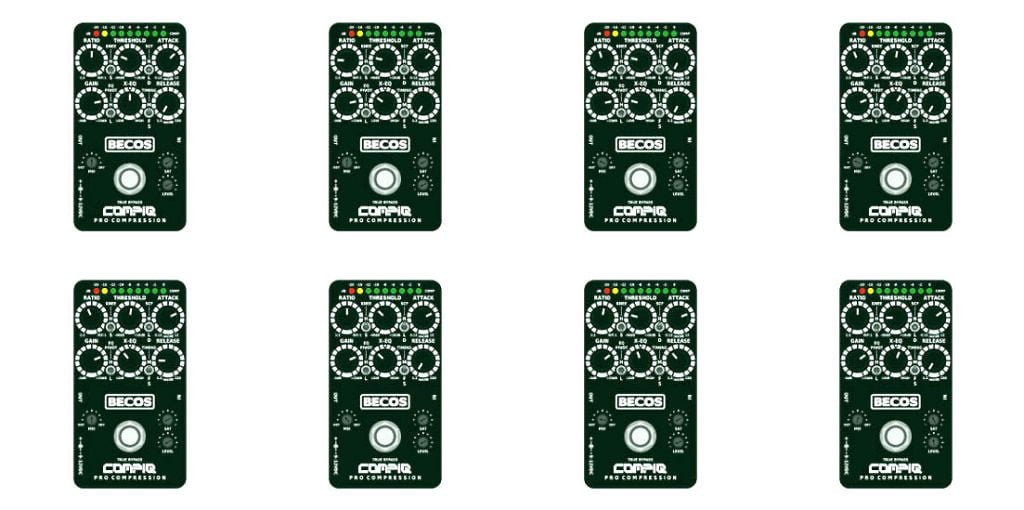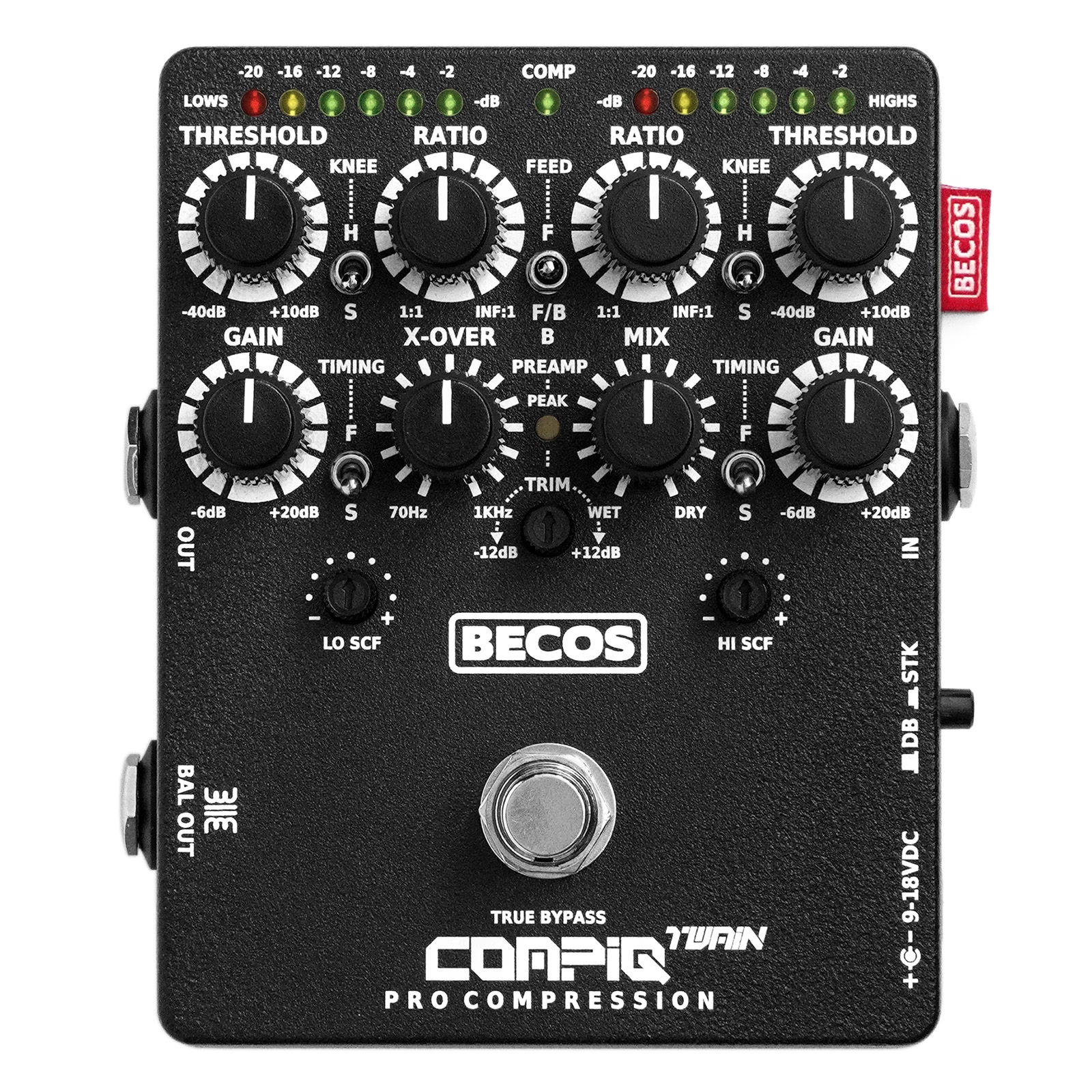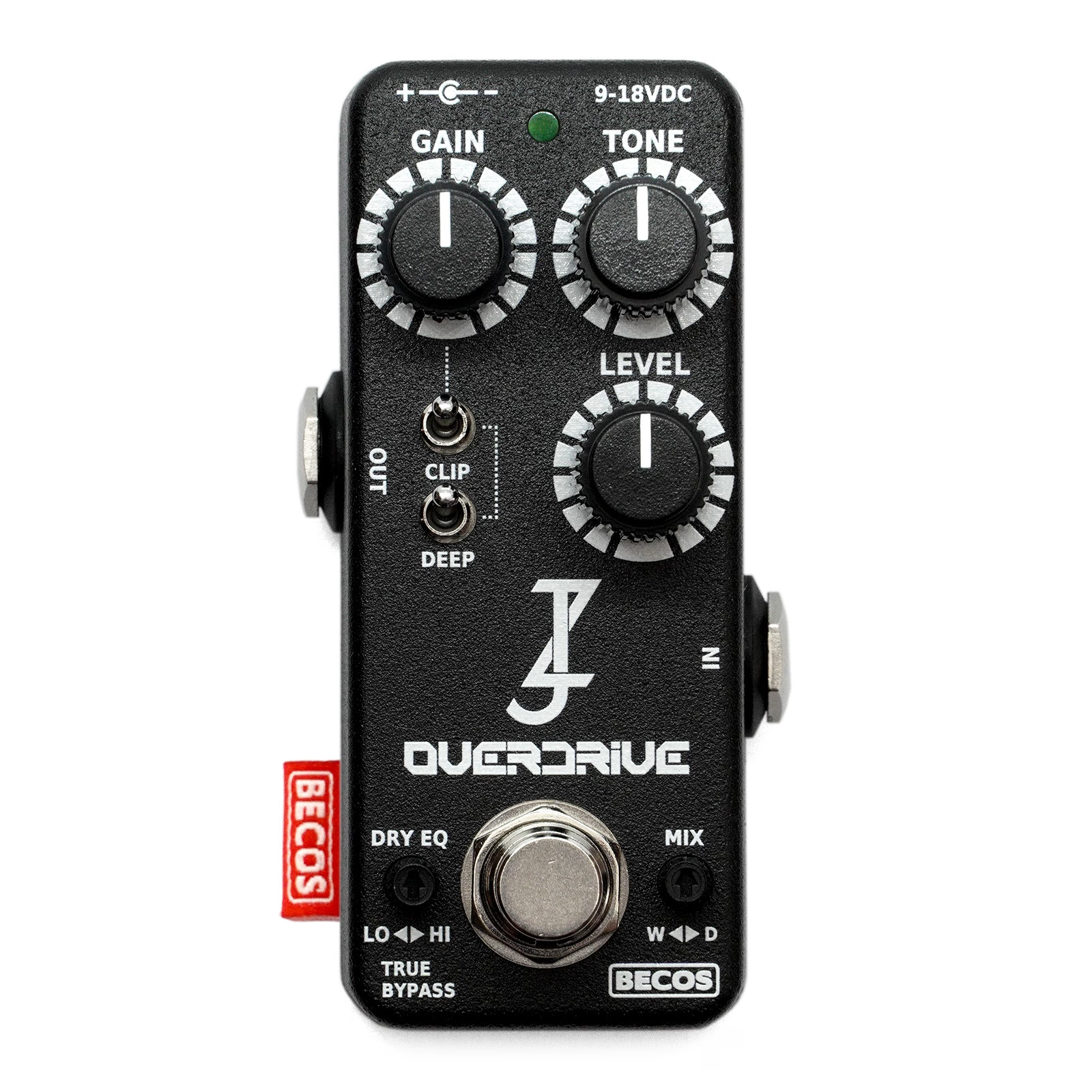IN THE PRESS
For more articles, reviews, and mentions, please check our Blog.
Usually, when I use a compression pedal, it’s more like an effect because it sounds cooler playing slap, rather than the use it to even out peaks. But the Stella can be set radically: you can hit only the high peaks with some nuances, or you can make it sound tight.
All in, the Stella manages to cram a dizzying number of top-quality features into a standard pedal. At all times, the tone was clear, clean and detailed in the way that I've come to expect from high-end studio plugins. Bravo!
In short, it’s what I’ve always wanted of a compressor pedal. The Stella can sound wonderfully transparent, or full of character, and there’s oodles of control at your fingertips. Bass players should absolutely love this thing (though I suspect they may be even more enamored with the company’s new split-band compressor).
Everything here exudes quality and fidelity. 'Pristine' is typically mostly used to describe particularly high quality Reverb algorithms, but it also very much applies here. And you can deploy this pedal very simply if you wish to - and mostly just using the 3 core Ratio, Threshold and Gain controls. You can leave pretty much everything else in the centre, set Fast or Slow Auto Timing, Hard/Soft Knee, and F or B Side Chain Feed - the pedal takes next to no time to set up in the most basic of fashions.
The CompIQ Stella has a ridiculous amount of power for a small stompbox. Better still, it's a transparent compression that only colors the tone as much as you allow it, unlike many lower-end boxes that simply squash tone and volume. That's the sign of a good unit - delivering compression power, clarity, and flexibility to control exactly what you want to hear from a guitar.
This pedal is designed to provide an array of features – with rack unit-levels of tweakability – in a pedalboard-friendly format. A highlight of the CompIQ Pro Stella Compressor is its analog tape saturation circuit.
CompIQ PRO Stella for guitar and bass delivers dizzying array of features. There are a staggering number of parameters onboard, which promise the versatility of a rack unit in a compact stompbox.
This is a highly versatile and pedal board friendly compressor. I'm not aware of anything on the market that packs this much punch in terms of functionality. In many ways, it has raised the bar for compressor pedals. The words "Pro Compressor" on the face of the compressor is appropriate. There is a whole lot of versatility in an amazingly small package.
Knob-heavy pedal offers compression, limiting, tape saturation and more.
WHAT USERS SAY
I just wanted to let you know, how much I enjoy my three Stella that come with the DI, incredible, simply incredible! I love them standalone with my P, and I also love them at the end of my quite complex chain for a wall of sound with a harmonized active BASS.
Michael J. W. - Germany
I wanted the TWAIN, but it seems to be sold out in Japan, so I got the STELLA MK2. I wonder if the TWAIN MK2 will also be released? If it is, I want it. It's more compact than the image suggested, about 15mm smaller, and the black color makes the board look tight and cool. BECOS CompIQ Stella Pro MK2 9V - Comparison with the original sound only. Even at 9V, I believe it's one of the top-class natural compressors that preserves the original sound very well. 12V - There's not a clear difference at low volumes, but if you want to bring the sound forward, 9V is preferable. If you seek depth and dimensionality, 18V might be the way to go, but 12V seems like a safe option if you're unsure. 18V - It's somewhat hard to discern in these recordings, but perhaps due to the wider headroom, it feels even more natural. I'd like to use this sound in the mix, I feel 9V or 12V might be more practical for band use (based on my experience with OD).
ブラウニー (Fuzzy Rock Funk Jazz), Japan
The Stella MK2 showed up today. The different voicings have a noticeable impact on the sound, and, in conjunction with the tilt EQ, can make for a wide tonal palette all on its own. Also, the additional side chain control for the high frequencies is a nice touch. To expound on the voicings just a little bit, there are two dip switches internally. Dip switch one set to on adds a lot of upper frequency content, and, when combined with the tilt EQ set to the 1kHz corner and rolled back a bit, gives a sound much like the hifi “tens and tweeters” kind of vibe: big bottom, strong lower mids, crispy highs, and a dip in the upper midrange. Dip switch two set to on cuts the low mids, and combining that with the tilt EQ set to the 330 Hz corner frequency and rolled back, gets into the Pultec low end trick vicinity. Both dip switches set to on is the stock 'tube' voicing, which adds heft to every note while having a less obvious EQ curve, and sounds really good (and is my immediate favorite early on). It’s the sort of sauce that the unvoiced mode doesn’t provide, and it’s a cool feature to be able to choose clean and transparent, or colored. Read the review.
Smurf-o-Deth on Talkbass Forum, USA
At all times, the tone was clear, clean and detailed in the way that I’ve come to expect from high-end studio plugins. […] This level of control would normally warrant one or even two rack spaces, so to have it available for a pedalboard is a godsend. […] Oh, did I mention the balanced DI out? A super-clean, studio quality second output to send to a desk or soundcard provides another ‘They’ve thought of everything’ moment. […] Bravo! Read the review

Steve Lawson, Bass Player Magazine, June 2022
Usually, when I use a compression pedal, it’s more like an effect because it sounds cooler playing slap, for example, rather than the use it to even out peaks. That’s why I preferred an easy-to-use comp. But the Stella can be set radically: you can hit only the high peaks with some nuances, or you can make it sound tight. The more granular controls, the more versatile it is, and I think you can do whatever you want with this pedal. Even if you apply a lot of compression, the amount of sound information does not decrease. It has a core body, so in that sense, it creates a high-quality impression. There is no noise and the build quality is high. Read the review

Masao Wada, Bass Magazine Japan
Really guys: Stella is the pedal I was looking for! It is the only compression pedal that provides this funky Strat sound I have in mind. I think in the long run I will try to get the Twain and have them both. Thanks a lot for the good work and keep it up.
Dan W. - Germany
Becos Stella - The best allround! Pros: A lot of pros on that one! I especially like the tape saturation which I found much better sounding than the tone color option of the Empress. I was surprised the Stella with tape saturation actually can come close to the Diamond sound, as Scubaduba pointed out in his review! Without tape saturation, it is transparent but has more bite than the Empress. What I like about Stella is how versatile it is and at the same time easy to dial in. Also convenient: Manual attack and release for fine-tuning or fixed setting for a quick setup. All these features are in a “normal” size pedal and there is still room for a 9V battery inside. That one is truly amazing! Cons: Can it be improved? Yes, I think so: It is very well built but the small knobs look fragile and the toggles are not easy to reach. Reviewed on Talkbass Forum
CheckBass (Netherlands) on Talkbass Forum
I purchased a Stella a few months ago. And what I can say right now... the pedal is absolutely wonderful. I use it mainly for tracking bass and mixing with the Stella as an insert in my DAW. So there are two things I want to say. First... thank you very much for this wonderful compressor. And second... I would love to get a stereo version!
Stefan D. - Germany
Whoop whoop! Look what I got today. After a real Odyssey regarding compressors, this one is finally a keeper. It's as transparent as I want it to be and actually dead quiet. Enough knobs to help me keep my dynamics in check and cut through the mix. Tapping is also super fun with this thing. Finally a decent compressor. Thanks, BECOS FX! Tweet
Raichoo (Tweeter) - Germany
Received the Stella today. Absolutely love this compressor. It sounds really great. It's quiet. All the controls have sensible ranges and as a result, do exactly what you expect them to. I'd thought the saturation control was a bit surplus to requirement, but after playing with it for a while, I'm really glad you decided to include it. It adds a lovely character to the tone and actually really helps from a 'sitting in the mix' point of view. I'm using passive basses and I have to have the threshold pretty low, so the bit of the range that I'm interested in tweaking is pretty narrow, but not unusably so. I guess the flip side of that is it'll be able to handle pretty much anything you throw at it in terms of level. I'm yet to try it with any active basses. Would be nice to see a couple of values marked around the ratio knob just to help navigate, but it's not hard to get used to. Also if the arrows on the mix and saturation controls were white, that would help some too. I'd sort of wanted an SCF knob rather than a switch, but the settings do roll off in very useful places. That said, I'd still easily take the ratio knob and SCF switch over a ratio switch and an SCF knob (like one of your competitors have), but I'd probably trade the EQ knob for an SCF knob (like the same competitors have). These are just minor points/preferences though and don't detract from how much I'm enjoying this pedal. It's an always-on thing for sure. Maybe you could turn the big off switch in the middle into an SCF knob? I'm pretty sure I'm not going to be turning it off :) You can tell how much thought has gone into this pedal, it's everything I'd hoped it would be and more. Feels like everything is exactly the way it is for a reason. It's also really nice to come across a company that is clearly passionate about what they do, as well as supporting their customers. Thanks for this excellent compressor and for your support!
Alex M. - United Kingdom
It is a pedal that is just right for a studio quality comp. It's packed with so many functions! But each control works well, and the range of sound creation is very wide. It is characterized by being clean and clear, yet it supports everything from natural compression that you do not know if it is there, to crisp ones that are tight. In addition, the SAT knob can be used to add a saturation effect, and it has various functions such as making the sound plump, making it a comp that enables aggressive sound creation. Thanks to the DRY / WET MIX and SAT, I am grateful that it is possible to create sounds that are convenient for the bass. You can use it not only on the guitar but also on the bass. Moreover, it is of high quality. Read full review (Japanese Language)
Asagi Bass - Japan
Howdy! Hey, my Becos arrived today, really a GREAT compressor! Super clean, no mud...Just what I was hoping for (actually it is even better then I'd hoped)! And all of those features are really useful to me, so I appreciate them. STUNNING COMPRESSOR!! Totally worth the money. You guys really know what the hell you're doing! ROCK ON!
Gayle E. - USA
Bass players should absolutely love this thing (though I suspect they may be even more enamored with the company’s new split-band compressor). In short, it’s what I’ve always wanted of a compressor pedal. It can sound wonderfully transparent, or full of character, and there’s oodles of control at your fingertips. Read the complete review.

Matt Houghton - Sound on Sound Magazine
I got the STELLA today and it is amazing. I bought this device as a compressor for an acoustic rig, but I made the mistake to try it with a Telecaster the (otherwise unused) overdrive section, which as a matter of fact sounds much better than the TS9 !! Dammit...it can also be blended with the compressor, it is crazy good you know. An excellent overdrive and still have to adjust with internal jumpers. So instead of spending an afternoon with the Taylor and the compressor, I spent an afternoon playing the overdriven telecaster with Stella(r) Overdrive. My setup is a hybrid acoustic or electric guitars straight into PA. When I use electric guitars, I enable the Ethos Clean preamplifier (Dumble emulator). The rig is DOUBLE STEREO into an onboard Yamaha mini mixer. Connection to PA is mixer-to-mixer balanced or unbalanced. I mostly play soundtracks using a Taylor 514, a Godin nylon and an electric PRS custom 24.The Becos Stella compressor is now permanently onboard, being extremely versatile and TRANSPARENT. And the capability of the side chain filter is unique because especially with acoustic and classic guitars it is imperative to exclude lower strings to engage the compressor. The manual is clear and exhaustive. I know it is a bit unfair, but I must say this Stella beats my previous [...] compressor every day and twice on Sundays. This is a real studio-grade unit. But the rock soul sometimes wakes up and I pick up a standard telecaster, bridge pickup, like today: heaven sound when overdriven by the Stella(r). The packaging is excellent, everything looks excellent and sounds great. You did a top of the line product! Thanks!
- Paolo V., Italy
The Becos CompIQ Stella Pro Compressor is a studio compressor housed in an MXR-sized chassis. Yet that tiny footprint offers no fewer than 13 controls, making it as powerful or as simple as you need. Another high-end feature is the Soft/Hard Knee compression switch, which lets you almost imperceptibly bring in warm compression after a certain point or a hard chop when you need to tame an unruly signal. Meanwhile, the Tape Saturation control dials in vintage distortion (think John Bonham's drums on LedZep records), and complements three Side-Chain Filter presets, Auto-Timing presets that respond to playing dynamics, an LED Gain Reduction display, and a 9-volt battery option. The CompIQ Stella has a ridiculous amount of power for a small stompbox. Better still, it's a transparent compression that only colors the tone as much as you allow it, unlike many lower-end boxes that simply squash tone and volume. That's the sign of a good unit - delivering compression power, clarity, and flexibility to control exactly what you want to hear from a guitar. Read the Review on Vintage Guitar Magazine USA - May 2020 Issue, p.106

- Pete Prown - Vintage Guitar Magazine USA
This is one of, if not the best pedal format compressor I have ever used. Being a VCA circuit it's not a one-trick pony, lends itself particularly well to transparent compression anyway, but coupled with the advanced features here its capable of incredibly transparent leveling to help 'glue' your bass into the mix better. Or fast enough attack speeds and extreme enough ratios and thresholds to make compression a fun in your face effect or super fat core tones completely achievable. If you want a tool to help on the gig, or to get a 'signature' compressed tone or a device in your hands to help you really get an understanding of what compression can do for you then this has to be really high up on your list. It certainly deserves to be there. I hope the review helps anyone sat on the fence over this little beauty! Read review on Basschat.co.uk
51m0n - Basschat.co.uk
This compression pedal helps me very much and replaces any external preamp that I've used. Very accurate and with so many features! Congratulations!

Decebal Badila - Musician / Jazz Artist / Bass Player
J’ai été agréablement surpris par la saturation du Stella qui combiné au « sidechain » et X-EQ permet de colorer le compresseur et d’obtenir un des sons intéressants comme par exemple une sonorité ampli à tube légère jusqu'à de la distorsion en passant par toutes le nuances possibles. Il n’existe à ma connaissance aujourd’hui aucun compresseur sur le marché qui fournisse autant de fonctionnalités dans des formats aussi compacts. Les CompIQ sont entièrement analogues, fait main en Roumanie, donc facilement accessible en Europe et à un prix plus que raisonnable pour les fonctionnalités et la qualité qu’ils offrent. Les CompIQ n’ont pas à rougir et mériteraient d’être plus connu sur le marché. Becos vient de sortir le CompIQ One pour ceux qui recherchent la simplicité mais avec les même exigences de qualité. Read review.
Geolikezik - Audio Fanzine (FR) & Bassonly.com
Whew. That's a lot. I'm not aware of any compressor on the market that packs this much punch in terms of functionality. In terms of feel and tone, I'd put the Becos CompIQ PRO Stella Compressor up against the likes of the Keeley Compressor Pro and Empress Compressor for sure. It has a similar inherent transparent quality to it. The X-EQ brings a tone shaping angle that the Keeley an Empress both can't touch. The saturation circuit is a whole new twist. The JHS Pulp 'N Peel also has an OD type circuit but it isn't as flexible as the Stella. With slight saturation added and blended well with the compressed signal, you'll get into Diamond compressor territory. In general, I think the Becos is quieter than the Keeley Compressor Pro at higher gain levels. This new offering from Becos is a highly versatile and pedal board friendly compressor. In many ways, it has raised the bar for compressor pedals. The words "Pro Compressor" on the face of the compressor is appropriate. From my perspective, Becos has done it again. I recommend this one. Read full review.
Chris T. - Talkbass.com
While I still enjoy my Mini, CompIQ Stella is another level !!! Not only it offers all the controls of a modern professional compressor but for a guy like me that dislike distortion, the Tape Saturation combined with moderate compression and the X-EQ (to recover/boost low frequencies) forced my admiration. I am able to get a nice warm yet light overdriven sound reminiscent of a slightly overdriven tube amp.
Georges E.
This pedal is designed to provide an array of features – with rack unit-levels of tweakability – in a pedalboard-friendly format. A highlight of the CompIQ Pro Stella Compressor is its analog tape saturation circuit. Read review.

Terence Stanley - Guitar Magazine
I've owned the Pro Stella for less than a month, but am already amazed at all the compression features crammed into a fairly small box -- and there's still room for tape saturation and a proper multi-LED gain reduction meter. 5 stars!
Anonymous
Bottom line: totally happy with the purchase. My compressor choice for each gig (when I opt for compression) has just gotten harder, as the Stella Pro is right there with the other great pedal comps I own: Empress, big-box Cali, Smoothie, DE-CL. I'm amazed by how much coolness was stuffed into such a small (and attractive) box, and the price is very nice. Special shout out for the awesome gain reduction LED ladder! Read review.
Fuzzbass - Talkbass.com Forum
I like to set Wet/Dry balance at about 60 Wet/40 Dry, Saturation very low but Sat Level full, so that there is a slight boost. The EQ is a very useful feature and I like to boost the treble a bit - I like to colour the signal a little. I feel that Stella can really liven up the sound, especially when playing clean and at relatively low volumes (I haven’t play loud yet). Although there are many controls, they are logical and straightforward. Generally, it doesn’t feel like I’m playing a compressor !now!, instead it’s just a pedal one could leave always on because it improves the clean sound.
- Nik V., Finland
We’ve seen rackmount studio compressors with fewer controls than this little pedal from Romanian maker Becos. This is a fully-featured unit compared to many guitar-pedal compressors, with sidechain filtering options and more. Single notes are thickened without thumping, and chords gel together in a way that somehow makes you sound like a better player. An analog tape-saturation circuit adds harmonic distortion for a warm, vintage feel. Hiss never becomes a problem, and dialing in some gritty tape saturation can be a great way to further energize a clean tone. This is a proper gem. With a score of 9 out of 10, it gets the Guitar.com Editor's Choice Badge. Read the review.

Richard Purvis - Guitar Magazine UK
This little squeezer packs rack-quality features, sound, and control into a pedal that will suit bass and guitar equally. In fact, you could use the Stella for pretty much any compression application including drums and voice. Nice one, Becos FX! Watch the review on YouTube

Brett Kingman - Gear Reviewer / Australia
Yay! What a great company! Thank you! Amazing gear. Cheers. Feedback on Reverb.com
Mike's Gear Bazaar - Reverb.com
Sonically, it's very transparent and I don't hear sucked out frequencies (even in bypass) the same way other pedal compressors do (ex: the EBS Multicomp). It's generally very quiet and does not add noises, etc. It's very very versatile. I could configure it as an exceptional limiter (with manual attack and release times). Finally a compressor with sufficiently quick attack time! Generally, I like to use it in the auto-slow, hard knee, low setting in the sensing circuit. I mainly play with fingers, plucking style. I'm not experimenting the same unbalance between low and high notes, as the FEA DE-CL does. It's equally good as between bass and preamp or in the insert of the preamp. I prefer the last option, because I put a Speck ASC eq before the compressor, in the insert chain. The X-EQ, which "on the paper" caught my eye, in reality, is a wonderful plus. I love it. It's very useful for clearing up a potentially muddy sound. Watch the video test.
Marco B.
Hello to the great folks at BECOS! Since we last emailed regarding the Becos One+ model, I was SO IMPRESSED with the One+ that I immediately purchased a Becos Stella model to take advantage of the germanium-like saturation it provides. Being that I play mostly retro-rock (50s, 60s, rockabilly, etc), a subtle tape-saturation circuit is critical to achieving authentic tones. As you can see by my pedal board, I do not have an overdrive, boost, or distortion pedal. I can achieve all the overdrive I need (and that's a lot actually) via three layered components in my signal chain by turning any one of them off or on as needed: Guitar in > Becos Stella Saturation > Boss Space Echo RE-202 tape saturation > natural headroom overdrive on my hand-built Fender '57 5E3 Deluxe. I honestly do not know why more guitarists have a Becos compressor on their board - It's like having a Ferrari on board versus a pick-up truck. Thanks again for making such a comprehensive, easy-to-use, and phenomenal-sounding studio-quality compressor in pedal form.
Steve S. - USA
Can't say that I'm an expert on compressor pedals, but I read a ton of reviews for a ton of pedals to make an informed choice. The most common complaint people have are dead spots on the controls, areas where the knobs do not have any noticeable effect. The Stella Compressor has no dead spots on any of the controls! Excellent! Definitely, something you can brag about in the product description!
B. Florian
The build quality is excellent, the pedal has a really solid feel and is a fair bit smaller than a Boss pedal [...] To summarise, a fantastic full featured transparent compressor with added bells and whistles. Sounds punchy with regular compression settings, great for slap and fingerstyle. Sounds really good as a limiter too with the Ratio set higher. When set at unity gain it adds a discernible improvement to the same basic tone. I'm really pleased. Read review.
Opticaleye - Basschat.co.uk
CompIQ PRO Stella for guitar and bass delivers dizzying array of features. There are a staggering number of parameters onboard, which promise the versatility of a rack unit in a compact stompbox. Read review.

Michael Astley-Brown - Total Guitar, Guitarist
Knob-heavy pedal offers compression, limiting, tape saturation and more. Read announcement.

Richard Bienstock - Guitar World
Becos FX announces the most feature-rich Compact Compressor available anywhere - the CompIQ Pro Stella. This needs some head-to-head benchmarking, but it looks mightily impressive on the surface! Read announcement.

Stefan Karlsson - GuitarPedalX
Pretty sweet huh? Yes indeed! It's like they stuffed a size 15 foot into a size 7 shoe...there's just too much kick ass packed into such a tiny space. That tape saturation is as right-on as I hoped it would be...and that's just a little bit of the icing on that cake. The best comparison I can come up with is that it's like the Pulp n' Peel except with a lot more control over more parameters. It can be transparent but it also has some serious punch when you dial it up. It was well worth the wait. Read the comments
L. D. Brown - Talkbass.com
I replaced it [ JHS Pulp'n'Peel ] with the Becos Stella. It's got the same punch, but offers a lot more control with all the knobs and switches... and that tape saturation is super sweet... way more usable than the dirt on the PnP, IMO. Read the comments
L. D. Brown - Talkbass.com
J'ai eu l'occasion d'essayer pas mal de chose. TC, MXR, Keeley, Empress, FEA, etc. Il n'y a pas a dire, ce sont aussi de bons produits mais... avec la BECOS STELLA, j'ai réellement trouvé ce que recherchais. Le fabriquant répond dans l'heure de manière précise. Il prend vraiment le temps de répondre dans les détails et on a à faire à quelqu'un de passionné. J'apprécie beaucoup ça. Les produits sont de très bonne qualité et pourtant dans des tarifs (pour le moment) raisonnables. Le modèle que j'ai pris offre des possibilités introuvables (à ma connaissance) sur une pédale de ce format et les fonctionnalités offertes ne sont pas des gadgets du tout pour quelqu'un qui recherche un compresseur de type studio. C'est très pro. C'est bien fait, ça sonne, c'est propre, c'est très complet, il y une personne très réactive derrière... Read the review in French Language.
J. F. Untrau - Onlybass.com
I always use it in live, both on an electric guitar or on acoustic/classical guitar. It works just great. I definitely recommend it.
C. V. Sorin - Customer Satisfaction Survey
Awesome product & great communication. Feedback on Reverb.com
- B. Pomerantz - Reverb.com
The CompIQ Stella Compressor is an always-on pedal in my pedalboard to sculpt my sound. The best compressor so far, very transparent, and easy to adjust. I couldn't be happier.
Alessandro C. - Italy
Really loving the Stella. It spoiled me so much that nothing else in pedal form comes in consideration. You really kicked it out of the park with that one, I am still amazed what level of control is possible. Stella is first in line and always on, followed by other four pedals that are in the switchable loop (the small enclosure below Stella). The power, the cabling and a Thumpinator (last thing before cable to amp) are below deck.
Vedran M. - Luxemburg
The DITOS board arrived last week and I installed it today. Thanks to your detailed instructions everything seems to be working properly :-) It has made a fantastic compressor even better! The process overall was easy. DITOS provides a great transformer-based DI, and for this application, enables me to place the Stella at the end of the chain without needing a DI on the board, which is also great! I couldn’t be happier with it. Note that I also recently purchased the new BECOS CompIQ Mini Pro MkII from @gearherohq That is also a truly splendid compressor. Truly splendid! It now lives on my main board, where the Stella used to be, and I also couldn’t be happier with it. You make truly amazing compressors - thank you again!
Dave K. - USA
COMPARE COMPRESSORS
The comparison table is best viewed on large screens, in landscape mode, preferably on desktop.
Circuit Design
Dynamic Processing
Analog Engines®
Control Element
Side-Chain Topology
Side-Chain Detection
Side-Chain Filter
Side-Chain Frequency Compensation
Voicing
Adjustable Input Level
Peak-level Indicator
Balanced Output
Crossover
Compression Ratio
Threshold
Dynamic Auto Timing
Attack Time
Release Time
Make-up Gain
Compression Knee
EQ
EQ Bypass
Dry/Wet Mix
Saturation
Saturation Filters
Compression Display
9V Battery Operation
DC Power Range
Current Consumption
More Info Compressor / Limiter
Dual Band / Stacking
2
Blackmer® VCA
Feed Forward / Feed-Back
True RMS-Level Sensor
Variable Lows / Highs
YES
-
±12dB
+0dBu input, +6dBu output
Transformer Balanced / Unbalanced (Floating) with optional DITOS output
Linkwitz–Riley
70Hz to 1KHz
1:1 to inf:1
both bands
-40dBu to +10dBu
both bands
Auto Fast / Slower
F: 5‐7ms / S: 10-15ms
F: 70ms / S: 100‐220ms
-6dB to +20dB
both bands
Hard / Soft
both bands
Unbalance Make-up Gains around X-over frequency pivot
-
YES
MK1
-
6-LED
both bands
-
9-18VDC center negative
Ø 5.1/2.1mm, 12mm long
< 95mAh @ 9VDC
< 170mAh @ 18VDC
Compressor / Limiter
Single Channel
1
Blackmer® VCA
Feed Forward / Feed-Back
True RMS-Level Sensor
Variable Lows / Highs
YES
Flat, Spark, Tight, Punch
-
-
-
1:1 to inf:1
-45dBu to +10dBu
Auto Fast / Slower
F: 5‐7ms / S: 10-15ms
Manual: 0.12 to 12 ms/dB
F / S: 70ms / 100‐220ms
Manual: 1.2 to 120 ms/dB
-6dB to +20dB
Hard / Soft
tilting X-EQ ±6dB
around 1kHz / 330Hz frequency pivots
MK1
YES
MK1
MK1
8-LED
YES
9-18VDC center negative
Ø 5.1/2.1mm, 12mm long
< 35mAh @ 9VDC
< 63mAh @ 18VDC
Compressor / Limiter
Single Channel
1
Blackmer® VCA
Feed Forward / Feed-Back
True RMS-Level Sensor
Variable Lows
YES
-
-
-
-
-
1:1 to inf:1
-40dbu to +10dBu
Auto Fast / Slower
F: 5‐7ms / S: 10-15ms
F: 70ms / S: 100‐220ms
-6dB to +20dB
Hard / Soft
-
-
YES
-
-
5-LED
-
9-12VDC center negative
Ø 5.1/2.1mm, 12mm long
< 25mAh @ 9VDC
< 38mAh @ 12VDC
Compressor
Single Channel
1
Blackmer® VCA
Feed Forward
True RMS-Level Sensor
Normal
YES
-
-
-
-
-
1:1 to inf:1
Lo: -40dBu / Hi: -30dBu
Auto Slow
12ms
220ms
-6dB to +20dB
Hard
-
-
YES
-
-
5-LED
-
9-12VDC center negative
Ø 5.1/2.1mm, 12mm long
< 15mAh @ 9VDC
< 23mAh @ 12VDC
Circuit Design
Dynamic Processing
Analog Engines®
Control Element
Side-Chain Topology
Side-Chain Detection
Side-Chain Filter
Side-Chain Frequency Compensation
Voicing
Adjustable Input Level
Peak-level Indicator
Balanced Output
Crossover
Compression Ratio
Threshold
Dynamic Auto Timing
Attack Time
Release Time
Make-up Gain
Compression Knee
EQ
EQ Bypass
Dry/Wet Mix
Saturation
Saturation Filters
Compression Display
9V Battery Operation
DC Power Range
Current Consumption
More Info
Compressor / Limiter
Dual Band / Stacking
2
Blackmer® VCA
Feed Forward / Feed-Back
True RMS-Level Sensor
Variable Lows / Highs
YES
-
±12dB
+0dBu input, +6dBu output
Transformer Balanced / Unbalanced (Floating) with optional DITOS output
Linkwitz–Riley
70Hz to 1KHz
70Hz to 1KHz
1:1 to inf:1
both bands
both bands
-40dBu to +10dBu
both bands
both bands
Auto Fast / Slower
F: 5‐7ms / S: 10-15ms
F: 70ms / S: 100‐220ms
-6dB to +20dB
both bands
both bands
Hard / Soft
both bands
both bands
Unbalance Make-up Gains around X-over frequency pivot
-
YES
MK1
-
6-LED
both bands
both bands
-
9-18VDC center negative
Ø 5.1/2.1mm, 12mm long
< 95mAh @ 9VDC
< 170mAh @ 18VDC
< 170mAh @ 18VDC
Compressor / Limiter
Single Channel
1
Blackmer® VCA
Feed Forward / Feed-Back
True RMS-Level Sensor
Variable Lows / Highs
YES
Flat, Spark, Tight, Punch
-
-
-
1:1 to inf:1
-45dBu to +10dBu
Auto Fast / Slower
F: 5‐7ms / S: 10-15ms
Manual: 0.12 to 12 ms/dB
Manual: 0.12 to 12 ms/dB
F / S: 70ms / 100‐220ms
Manual: 1.2 to 120 ms/dB
Manual: 1.2 to 120 ms/dB
-6dB to +20dB
Hard / Soft
tilting X-EQ ±6dB
around 1kHz / 330Hz frequency pivots
around 1kHz / 330Hz frequency pivots
MK1
YES
MK1
MK1
8-LED
YES
9-18VDC center negative
Ø 5.1/2.1mm, 12mm long
< 35mAh @ 9VDC
< 63mAh @ 18VDC
< 63mAh @ 18VDC
Compressor / Limiter
Single Channel
1
Blackmer® VCA
Feed Forward / Feed-Back
True RMS-Level Sensor
Variable Lows
YES
-
-
-
-
-
1:1 to inf:1
-40dbu to +10dBu
Auto Fast / Slower
F: 5‐7ms / S: 10-15ms
F: 70ms / S: 100‐220ms
-6dB to +20dB
Hard / Soft
-
-
YES
-
-
5-LED
-
9-12VDC center negative
Ø 5.1/2.1mm, 12mm long
< 25mAh @ 9VDC
< 38mAh @ 12VDC
< 38mAh @ 12VDC
Compressor
Single Channel
1
Blackmer® VCA
Feed Forward
True RMS-Level Sensor
Normal
YES
-
-
-
-
-
1:1 to inf:1
Lo: -40dBu / Hi: -30dBu
Auto Slow
12ms
220ms
-6dB to +20dB
Hard
-
-
YES
-
-
5-LED
-
9-12VDC center negative
Ø 5.1/2.1mm, 12mm long
< 15mAh @ 9VDC
< 23mAh @ 12VDC
< 23mAh @ 12VDC





























